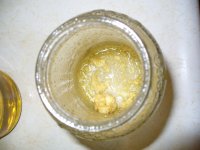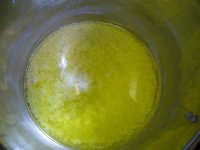arcologist
Rising Star
So I've been trying an ACRB extraction and I've got to the point where I can reliably get pure white crystals to freeze precipitate.
My method is STB with 60g NaOH/L, 4x pulls with heated naphtha, evaporate to goo, dissolve goo in acetone, convert to DMT/NMT fumarate with fumaric acid, settle and decant acetone (removing plant oils), redissolve fumarate goo in water, base with 20g/L NaOH, 1 or 2 room-temperature pulls with naphtha, leaving most NMT behind, freeze precipitate for 12+ hours.
However, these crystals turn to goo at room temperature, probably due to some small amount of NMT present in them. I've tried various methods of drying/raising the temperature slowly, but nothing has worked.
I saw a paper posted here (attached) from 1964 which claims that bubbling CO2 through a NP-solvent solution of secondary and tertiary amines will cause the secondary amine-carbamate to precipitate. Since NMT is a secondary amine and DMT is a tertiary amine, it should be possible to separate them in this manner.
My idea is too dissolve my NMT/DMT crystal goo in a non-polar solvent (naphtha or maybe xylene?), then put a small piece of dry ice (solid CO2) into the solution. The dry ice will sublime, creating CO2 bubbles that should run the above reaction. It will eventually all sublime, leaving your solvent ready to be filtered to remove the NMT carbamate.
Does anyone see any potential problems with this experiment? It seems like the easiest way to generate controlled amounts of CO2 and hopefully separate the rest of the NMT.
___________________________________________________________________
Update: 10/25/2013
I have had the chance to try this technique in a few different permutations with moderate to good success. Some other users have reported some moderate success with this method, but most with low yields. I have had yields of around 0.7%, extracting from the same source of bark each time.
So far, I have had the best results using xylene for the dry ice reaction. The reason for this is because only the NMT carbamate precipitates using xylene, but with naphtha, much of the DMT precipitates due to the drop in temperature caused by the dry ice. This requires a hot water bath to raise the temperature of the naphtha enough to redissolve the DMT (leaving the NMT insoluble). Using naphtha may reduce the final yield of DMT because some solid DMT gets trapped in the NMT carbamate residue.
It is best to collect all pulls and to add dry ice to all of them together, but to no more than 250-400ml of solvent at a time. More liquid than that and there is the chance that the CO2 doesn't react with all of the NMT.
Images:
1. NMT Carbamate precipitates using dry ice from xylene
2. NMT Carbamate/DMT freebase precipitated from naphtha, before heat bath.
My method is STB with 60g NaOH/L, 4x pulls with heated naphtha, evaporate to goo, dissolve goo in acetone, convert to DMT/NMT fumarate with fumaric acid, settle and decant acetone (removing plant oils), redissolve fumarate goo in water, base with 20g/L NaOH, 1 or 2 room-temperature pulls with naphtha, leaving most NMT behind, freeze precipitate for 12+ hours.
However, these crystals turn to goo at room temperature, probably due to some small amount of NMT present in them. I've tried various methods of drying/raising the temperature slowly, but nothing has worked.
I saw a paper posted here (attached) from 1964 which claims that bubbling CO2 through a NP-solvent solution of secondary and tertiary amines will cause the secondary amine-carbamate to precipitate. Since NMT is a secondary amine and DMT is a tertiary amine, it should be possible to separate them in this manner.
My idea is too dissolve my NMT/DMT crystal goo in a non-polar solvent (naphtha or maybe xylene?), then put a small piece of dry ice (solid CO2) into the solution. The dry ice will sublime, creating CO2 bubbles that should run the above reaction. It will eventually all sublime, leaving your solvent ready to be filtered to remove the NMT carbamate.
Does anyone see any potential problems with this experiment? It seems like the easiest way to generate controlled amounts of CO2 and hopefully separate the rest of the NMT.
___________________________________________________________________
Update: 10/25/2013
I have had the chance to try this technique in a few different permutations with moderate to good success. Some other users have reported some moderate success with this method, but most with low yields. I have had yields of around 0.7%, extracting from the same source of bark each time.
So far, I have had the best results using xylene for the dry ice reaction. The reason for this is because only the NMT carbamate precipitates using xylene, but with naphtha, much of the DMT precipitates due to the drop in temperature caused by the dry ice. This requires a hot water bath to raise the temperature of the naphtha enough to redissolve the DMT (leaving the NMT insoluble). Using naphtha may reduce the final yield of DMT because some solid DMT gets trapped in the NMT carbamate residue.
It is best to collect all pulls and to add dry ice to all of them together, but to no more than 250-400ml of solvent at a time. More liquid than that and there is the chance that the CO2 doesn't react with all of the NMT.
Images:
1. NMT Carbamate precipitates using dry ice from xylene
2. NMT Carbamate/DMT freebase precipitated from naphtha, before heat bath.




